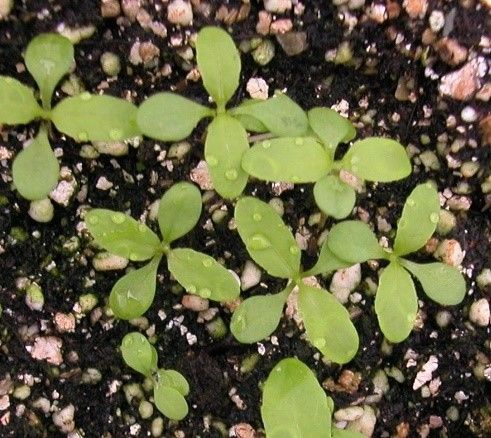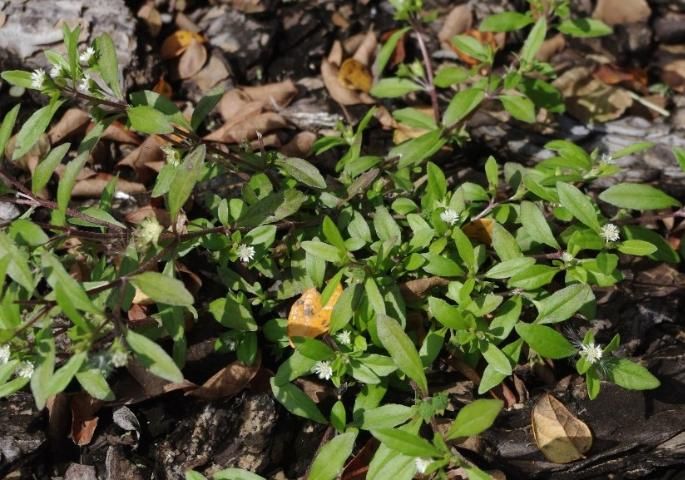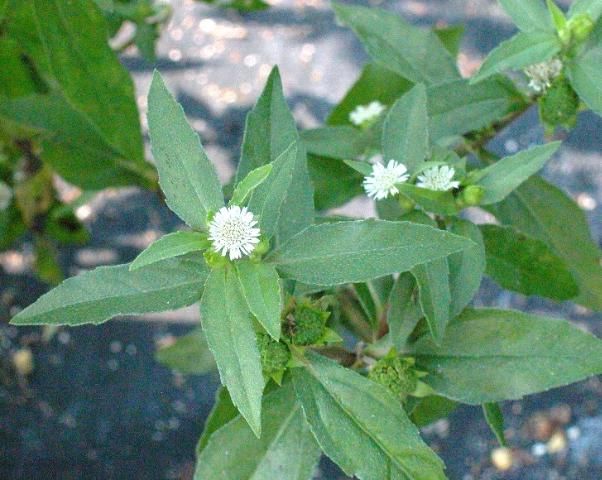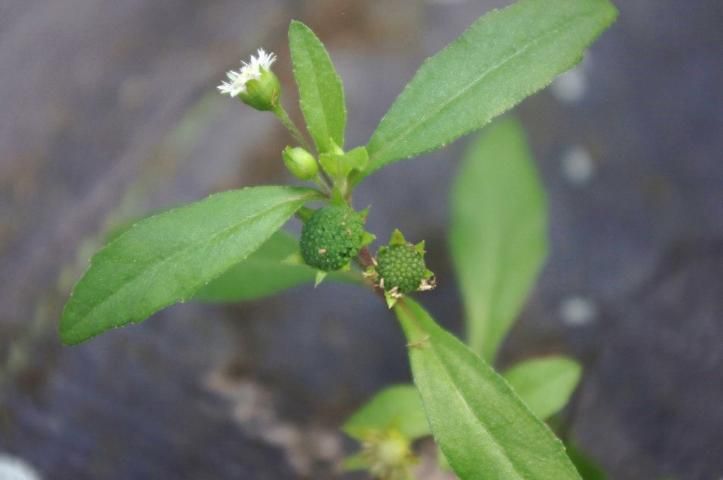Species Description
Class: Dicotyledonous plant
Family: Asteraceae (aster or sunflower family)
Other Common Names: False daisy, yerba-de-tago
Life Span: Summer annual
Habitat: Occurs in moist, disturbed areas from spring to fall. Often found in drain holes of containers or near irrigation risers. Usually found in full-sun areas.
Distribution: Eclipta is thought to be native to Asia but is widely naturalized around the world. In the U.S., it is most widely distributed in southeast, southwest, midwest, and east coast regions (Holm et al. 1979; USDA NRCS 2014).
Growth Habit: Prostrate (spreading) or erect (upright) up to 3 feet tall.
Seedling: Cotyledons are pale green with opposite, spatulate (spatula-shaped) leaves with smooth margins. First true leaves are more elliptical in shape and often have a noticeable white midvein on lower surface of leaf (Figure 1).

Credit: Annette Chandler, UF/IFAS
Shoot: Stems are reddish to purple; covered with short, stiff hairs; and root at the lower nodes. Leaves are simple, opposite, dull green, ovate (oval shaped) to lanceolate (narrow oval shape tapering to a point), and 2 to 10 cm long and 1 to 3 cm wide. Leaf margins can be entire (smooth) or slightly serrate (toothed). Leaves are usually hairy and mostly sessile (without petiole) (Figure 2).

Credit: Annette Chandler, UF/IFAS
Roots: Fibrous with shallow taproot.
Inflorescence: Each flower head is composed of small, white ray-and-disc flowers 1 cm in diameter that are formed on stalks in the leaf axis and occur as singles or in pairs. Flowers from spring to early fall (Figure 3).

Credit: Annette Chandler, UF/IFAS
Fruit and Seeds: Each flower head produces multiple achenes that turn light brown to black as they begin to mature and then fall, leaving behind small cup-like structures (Figure 4). One eclipta plant can produce over 17,000 seeds in one growing season (Prostko 2012).

Credit: Annette Chandler, UF/IFAS
Similar Species: Galinsoga (Galinsoga parviflora or Galinsoga quadriradiata) are related species but have wider, triangular-shaped leaves and yellow disk flowers. Alligator weed (Alternanthera philoxeroides) is another species that is similar in appearance but has smooth leaf margins and hollow stems and is found in aquatic habitats.
Plant Biology
Eclipta generally occurs from spring to fall in north and central Florida and year-round in south Florida. It germinates over a wide range of pH, salt, and temperature conditions and preferentially germinates when the seed is on or near the soil or media surface (Chauhan and Johnson 2008). Eclipta germination is greater in warm, moist soils and as a result it typically occurs in poorly drained fields, irrigated areas, or during periods of heavy rainfall (Prostko 2012). Persistence in fields and container production is due to the thousands of seeds produced per plant over the course of a growing season. Plants can flower in as little as five weeks after germination and produce seeds with no dormancy within 6 to 7 weeks that germinate quickly (Gupta 1992). Eclipta can also reproduce vegetatively through adventitious rooting of nodes or from stem fragments left on the soil or media surface following hand-weeding or cultivation. Eclipta grows aggressively in containers and can outcompete nursery crops for water, nutrients, and light.
Management
Physical and Cultural Control
Eclipta is not drought tolerant and germinates poorly in dry soils. Grouping plants by water requirement, improving irrigation efficiency, installing rain sensors, and other practices that improve water-use efficiency may reduce incidence. Due to its extensive root system, hand-weeding mature eclipta in nursery containers is very difficult and can cause significant soil disturbance in the pots. Much of the root system and stem fragments often are left behind and can re-grow. Hand-weed plants as soon as possible when eclipta are still small. Ensure propagation areas are weed free. Keep equipment, surrounding fields, and other areas free of eclipta, as walking through an area can quickly transfer seeds. Control eclipta in non-crop areas or row middles by mowing or using densely growing groundcovers, gravel, or ground cloth. Coarse-textured mulches at depths of 1 inch or more may reduce germination in nursery containers or other areas (Cochran et al. 2009). In the field, cultivation by hoeing or tilling will provide control of emerged plants but may not reduce germination.
Chemical Control
Preemergence
Many herbicides will provide partial control or suppression, but it is difficult to achieve adequate season-long control (Neal and Derr 2005). Most preemergent herbicides labeled for use in ornamentals are heavily DNA (dinitroaniline)-based or contain oxyfluorfen, both of which usually are ineffective on eclipta when used alone. Preemergent herbicides that control or suppress eclipta include indaziflam (Marengo®), flumioxazin (Broadstar®, SureGuard®), and dimethenamid-p (Tower®, and as a component of FreeHand®), among others. A partial list of preemergent herbicides labeled for use in and around ornamentals is given in Table 1.
Postemergence
Many postemergent herbicides are effective for eclipta control, but most have to be applied as a directed application. Effective active ingredients include glyphosate (RoundUp®), glufosinate (Finale®), diquat (Reward®), pelargonic acid (Scythe®), among several others. Both systemic and contact herbicides will provide effective control, but thorough coverage is needed for contact herbicides such as diquat or pelargonic acid. Imazaquin (Image®) controls eclipta postemergence and can be applied over the top of several ornamental species in the landscape but cannot be applied in nurseries. Postemergent herbicides are most effective when the weeds are small and actively growing. Always consult the manufacturer's label and follow all precautions when applying herbicides.
References
Chauhan, B. S. and D. E. Johnson. 2008. "Influence of Environmental Factors on Seed Germination and Seedling Emergence of Eclipta (Eclipta prostrata) in a Tropical Environment." Weed Science 56:383–388.
Cochran, D. R., C. H. Gilliam, D. J. Eakes, G. R. Wehtje, P. R. Knight, and J. Olive. 2009. "Mulch Depth Affects Weed Germination." J. Environ. Hort. 27:85–90.
Gupta, P. L. 1992. "Seed Germination Study of Eclipta prostrata Linn." Advances in Plant Sciences 5:187–189.
Holm, L. G., J. V. Poncho, J. P. Herberger, and D. L. Plunknett. 1979. A Geographical Atlas of World Weeds. New York: John Wiley and Sons.
Prostko, E. P. 2012. "Eclipta Identification and Control in Peanut." Circular 869. Athens, GA: University of Georgia Coop. Extn..
Neal, J. C. and J. F. Derr. 2005. Weeds of Container Nurseries in the United States. Raleigh, NC: North Carolina Assoc. of Nurserymen, Inc.
USDA National Resources Conservation Service. 2014. "The PLANTS Database." Greensboro, NC: National Plant Data Team. http://plants.usda.gov.